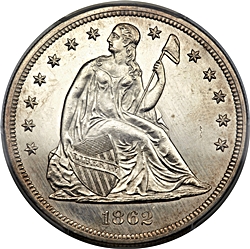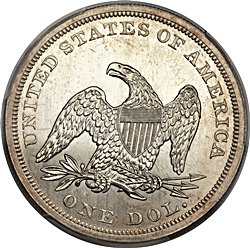 |
1862
 

|
 |
General Comments
In 1862 silver dollar mintage plummeted to just over 12,000 coins. This date has always been popular
due to both the low mintage and its status as a Civil War date. 1862 coins are rare in any grade.
Availability is similar to the previous years, but the date is less underrated than either 1859 or
1860. As with the 1861 the market has recognized its rarity, and nice examples are usually priced
accordingly. Despite this they often sell for well above listings in current price guides.
|
| |||||||||||||||||||||
1862 examples are normally very well struck. Star centrals are usually sharply defined, and all other details above average. Reverses are almost always sharp. High-grade business strikes are often prooflike or semi-prooflike. With less than 12,000 business strikes the dies didnít get a chance to wear off their initial prooflike surfaces.
1862 Die Marriages
3 die marriages have been positively identified. A single die pair was used to strike all business strikes. Neither die was used for proofs. A single obverse die was paired with two different reverses to produce two proof die marriages. The following table summarizes the known die marriages for 1862:
Click the links below to view the details of each die marriage.
Die Marriage |
Rarity |
Obverse Die |
Reverse Die |
Estimated Survivors |
| OC-1 | R3 | 1 | A | 350 |
| OC-P1 | R5 | P1 | PA | 50 |
| OC-P2 | R3+ | P1 | PB | 200 |
Breen (reference 7) identifies only a single 1862 proof die marriage, but indicates that the reverse die was also used to strike the 1853 proofs, which most authors identify as restrikes. We addressed the restrike question in our description of the 1853 proofs. Breenís identification of the 1862 proof reverse as the one used in 1862 is incorrect. Weíve compared both 1862 proof reverse dies to the one used to strike the 1853 proofs and have failed to find a match.
1862 Business Strike Emission Sequence
With only a single business strike die marriage the emission sequence is simple.
Emission Order |
Die Marriage |
Comments |
| 1 | OC-1 |
1862 Proof Emission Sequence
We believe that the progression of die polish on Obverse P1 indicates that the sequence listed below is correct.
However, the differences are minor. The sequence below is our best estimate.
Emission Order |
Die Marriage |
Comments |
| 1 | OC-P1 | |
| 2 | OC-P2 | Die polish slightly reduced the unfinished area under the chin |
1862 Quick Finder Chart
Attribution of 1862 die marriages is relatively easy. Neither the obverse nor reverse dies display major markers,
but the obverse date positions are notably different on the two known obverse dies. The only challenge is
differentiating the two known proof reverse dies. Fortunately proofs are usually relatively high grades,
making the minor diagnostics clearly visible. The following table lists the keys for identifying each variety.
Die Marriage |
Obv Die |
Rev Die |
Right |
Keys |
| OC-1 | 1 | A | B | Obverse: 1 is VSH. Reverse: Die rust between lower and middle leaves. |
| OC-P1 | P1 | PA | C | Obverse: 1 is SL. Reverse: : 1-2 to 2. A light die line joins the lower and middle leaves in the unfinished area between them. Minor unfinished areas at the lower end of the middle and left-side shield recesses. |
| OC-P2 | P1 | PB | C | Obverse: 1 is SL. Reverse: 1-1 and 1-3 to 2. The lower ends of the middle and left-side shield recesses are completely finished to the shield edge. Often seen with broken ends on the middle and upper leaves. |
| Photo credits:
Obverse and reverse full photos: 1862 PCGS MS64, from the Heritage archives. |
